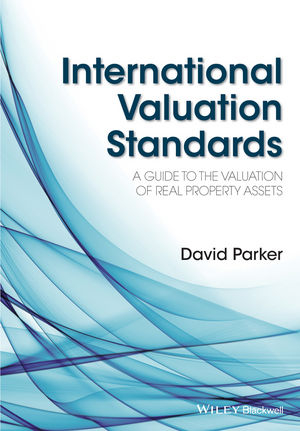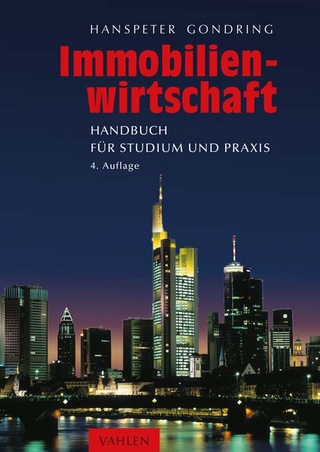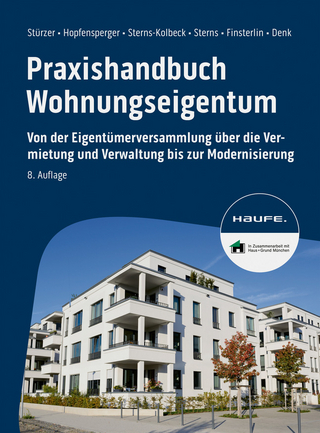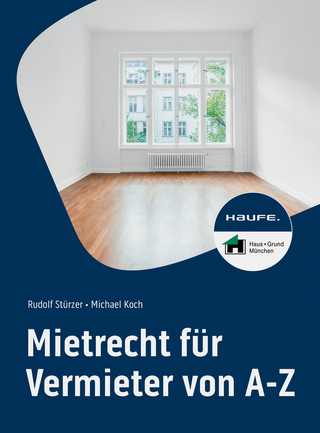
International Valuation Standards
Wiley-Blackwell (Verlag)
978-1-118-32936-8 (ISBN)
Professor David Parker is an internationally recognised property industry expert on both the theory and practice of REITs, and a highly regarded property academic, being a director and adviser to property investment groups including listed real estate investment trusts, unlisted funds and private property businesses (www.davidparker.com.au). Professor Parker is currently the inaugural Professor of Property at the University of South Australia, an Adjunct Professor of Property at the University of Queensland, a Visiting Fellow at the University of Ulster and an Acting Commissioner of the Land and Environment Court of New South Wales. With over 25 years experience in all aspects of property fund management, portfolio management, asset management and property management as well as in property valuation, Professor Parker previously held senior executive positions with Schroders Property Fund and ANZ Funds Management. Professor Parker consults widely to REITs and property funds, having developed Clarity(r), a proprietorial research based property investment decision making process linking corporate vision to individual property assets. Holding BSc, MComm, MBA and PhD degrees, Professor Parker is a Fellow of the RICS, the Australian Institute of Company Directors, the Australian Property Institute, the Australian Institute of Management and the Financial Services Institute of Australasia. He is a member of the Society of Property Researchers, the American Real Estate and Urban Economics Association and the European, American and Pacific Rim Real Estate Societies. The author of numerous papers published in academic and industry journals, Professor Parker is a regular conference presenter around the world and Editorial Board Member for the highly ranked Journal of Property Research, the Pacific Rim Property Research Journal and Property Management.
Foreword xv
About the Author xvii
Preface xix
Acknowledgements xxi
Introduction 1
1 Market Value 3
1.0 Introduction 3
1.1 Globalisation and valuation 4
1.1.1 Globalisation 5
1.1.2 International Financial Reporting Standards 6
1.1.3 Valuation 8
1.2 Evolution of valuation standard setting 10
1.2.1 Principal phases 10
1.2.2 Role of IVSC 12
1.2.3 Role of IVSs 13
1.2.3.1 Structure of IVSs 13
1.2.3.2 International, Regional and National Valuation Standards 16
1.3 Market value 17
1.3.1 Spencer concept of market value 18
1.3.2 IVS definition of market value 20
1.3.2.1 Estimated amount 22
1.3.2.2 An asset should exchange 23
1.3.2.3 On the valuation date 23
1.3.2.4 Between a willing buyer 23
1.3.2.5 And a willing seller 24
1.3.2.6 In an arm’s length transaction 25
1.3.2.7 After proper marketing 25
1.3.2.8 Where the parties had each acted knowledgably, prudently 26
1.3.2.9 And without compulsion 27
1.3.3 Highest and best use assumption 28
1.3.4 Transaction costs assumption 29
1.3.5 Market value in practice 30
1.4 Businesses and business interests, intangible assets and financial instruments 31
1.4.1 Businesses and business interests 31
1.4.2 Intangible assets 32
1.4.3 Financial instruments 32
1.5 Summary and conclusions 33
References 35
2 Concepts 37
2.0 Introduction 37
2.1 Conceptual framework 38
2.1.1 Approaching IVSs through economic theory 40
2.1.2 Concept of exchange 43
2.1.3 Conceptual framework – summary 46
2.2 Reconciliation with capital market theory 48
2.3 Definition of the market 50
2.3.1 What is a market? 50
2.3.2 Who are the participants in a market? 53
2.3.3 What is the role of market activity? 54
2.3.4 What is an asset? 56
2.3.5 Definition of the market – summary 57
2.4 Value vs. cost vs. price 58
2.4.1 Price 58
2.4.2 Cost 58
2.4.3 Value 59
2.4.3.1 Market value 60
2.4.3.2 Investment value 62
2.4.3.3 Synergistic value 65
2.4.3.4 Fair value 67
2.4.3.5 Special value 70
2.4.3.6 Relative contribution to value 72
2.4.4 Reconciliation to the conceptual framework for valuation 73
2.5 Summary and conclusions 74
References 77
3 Definitions 79
3.0 Introduction 79
3.1 Definition of valuation 80
3.1.1 What is valuation? 81
3.1.2 What is value? 82
3.1.3 What is a basis of value? 82
3.1.4 What is a valuation input? 86
3.1.5 What is an assumption? 89
3.1.6 What is a special assumption? 90
3.1.7 Definition of valuation – summary 92
3.2 Definition of contextual terms 93
3.2.1 Real estate 93
3.2.2 Real property 94
3.2.3 Investment property 96
3.2.4 Trade related property 97
3.2.5 Intangible asset 98
3.2.6 Goodwill 98
3.2.7 Market rent 98
3.2.8 Definition of contextual terms – summary 99
3.3 Principal approaches to valuation 99
3.3.1 Cost approach 100
3.3.2 Income approach 102
3.3.2.1 Income capitalisation 102
3.3.2.2 Discounted cash flow 104
3.3.2.3 Option pricing models 105
3.3.3 Market approach 105
3.3.3.1 Accumulation step 106
3.3.3.2 Analysis step 107
3.3.3.3 Adjustment step 107
3.3.3.4 Application step 108
3.3.3.5 Market approach – summary 109
3.3.4 Principal approaches to valuation – summary 109
3.4 Summary and conclusions 110
References 111
4 Valuation Process 113
4.0 Introduction 113
4.1 Preliminary questions 114
4.2 Instructing the valuer 116
4.2.1 Transparency 116
4.2.2 Nominated issues to be addressed in written instructions 117
4.2.2.1 Identification and status of valuer 118
4.2.2.2 Identification of the client and any other intended users 119
4.2.2.3 Purpose of the valuation 120
4.2.2.4 Identification of the asset or liability to be valued 120
4.2.2.5 Basis of value 121
4.2.2.6 Valuation date 122
4.2.2.7 Extent of investigation 122
4.2.2.8 Nature and source of the information to be relied upon 123
4.2.2.9 Assumptions and special assumptions 123
4.2.2.10 Restriction on use, distribution or publication 124
4.2.2.11 Confirmation that the valuation will be undertaken in accordance with the IVS 125
4.2.2.12 Description of report 125
4.2.3 IVS 101 in practice 126
4.3 Undertaking the valuation 126
4.3.1 Extent and nature of investigation 127
4.3.2 Selection of approach or method 128
4.3.3 Record keeping 129
4.3.4 IVS 102 in practice 129
4.4 Reporting the valuation 130
4.4.1 Transparency 131
4.4.2 Nominated issues to be addressed in the valuation report 131
4.4.2.1 Identification and status of valuer 132
4.4.2.2 Identification of the client and any other intended users 133
4.4.2.3 Purpose of the valuation 133
4.4.2.4 Identification of the asset or liability to be valued 133
4.4.2.5 Basis of value 134
4.4.2.6 Valuation date 134
4.4.2.7 Extent of investigation 134
4.4.2.8 Nature and source of the information to be relied upon 134
4.4.2.9 Assumptions and special assumptions 135
4.4.2.10 Restriction on use, distribution or publication 136
4.4.2.11 Confirmation that the valuation will be undertaken in accordance with the IVS 136
4.4.2.12 Valuation approach and reasoning 137
4.4.2.13 Amount of the valuation or valuations 137
4.4.2.14 Date of the valuation report 138
4.4.2.15 Reporting the valuation 138
4.4.3 IVS 103 in practice 138
4.5 Summary and conclusions 139
References 141
5 Valuation of Investment Property 143
5.0 Introduction 143
5.1 Valuation of investment property 144
5.1.1 IVS 230 Real Property Interests 145
5.1.1.1 IVS 230 Real Property Interests in practice 146
5.1.2 IVS 220 Plant and Equipment 147
5.1.2.1 IVS 220 Plant and Equipment in practice 148
5.1.3 TIP 1 Discounted Cash Flow 149
5.1.3.1 Income capitalisation approach 150
5.1.3.2 Discounted cash flow approach 151
5.1.3.3 TIP 1 Discounted Cash Flow 152
5.1.3.4 IFRS 13 Fair Value Measurement 155
5.1.3.5 Summary – Valuation of investment property in IVSs 157
5.1.4 Investment property in IFRS 157
5.1.4.1 IAS 40 Investment Property 158
5.1.4.2 IAS 36 Impairment of Assets 161
5.1.4.3 IFRS 5 Non-Current Assets Held for Sale and Discontinued Operations 161
5.1.4.4 IAS 17 Leases 161
5.1.4.5 IVS 233 Investment Property Under Construction 162
5.1.4.6 Summary – Investment property in IFRS’s 165
5.2 Valuation of investment property for financial reporting 165
5.2.1 IVS 300 Valuations for Financial Reporting 166
5.2.1.1 IVS 300 Valuations for Financial Reporting in practice 167
5.2.2 IFRS 13 Fair Value Measurement 168
5.2.2.1 IFRS 13 highest and best use 169
5.2.2.2 IFRS 13 definition of fair value 169
5.2.2.3 IFRS 13 valuation techniques 174
5.2.2.4 IFRS 13 fair value hierarchy of inputs 175
5.2.2.5 IFRS 13 Fair Value Measurement in practice 179
5.2.3 Valuation of investment property for financial reporting 180
5.3 Valuation of investment property for secured lending 181
5.3.1 IVS 310 Valuations of Real Property Interests for Secured Lending 181
5.3.1.1 Valuation instructions and valuation reporting 181
5.3.1.2 Cautionary issues in valuations of real property for secured lending purposes 182
5.3.1.3 IVS 310 Valuations of Real Property Interests for Secured Lending in practice 183
5.3.2 Summary – Valuation of investment property for secured lending 185
5.4 Summary and conclusions 185
References 187
6 Valuation of Owner Occupied Property 189
6.0 Introduction 189
6.1 Valuation of owner occupied property 190
6.1.1 IVS 230 Real Property Interests 191
6.1.1.1 IVS 230 Real Property Interests in practice 193
6.1.2 IVS 220 Plant and Equipment 194
6.1.2.1 IVS220 Plant and Equipment in practice 196
6.1.3 TIP 2 The Cost Approach to Tangible Assets 197
6.1.3.1 Bases of value 199
6.1.3.2 Value of land 200
6.1.3.3 Reproduction or replacement of buildings and/or improvements 200
6.1.3.4 Cost elements 202
6.1.3.5 Depreciation 203
6.1.3.6 Summary – Valuation of owner occupied property in IVSs 206
6.1.4 Owner occupied property in IFRS 207
6.1.4.1 IAS 16 Property, Plant and Equipment 207
6.1.4.2 IAS 36 Impairment of Assets 212
6.1.4.3 IFRS 5 Non-Current Assets Held for Sale and Discontinued Operations 213
6.1.4.4 IAS 17 Leases 214
6.1.4.5 Summary – Owner occupied property in IFRS 215
6.2 Valuation of owner occupied property for financial reporting 215
6.2.1 IVS 300 Valuations for Financial Reporting 216
6.2.1.1 Aggregation 216
6.2.1.2 Depreciation 217
6.2.1.3 Classification of property leases 219
6.2.1.4 IVS 300 Valuations for Financial Reporting in practice 219
6.2.2 IFRS 13 Fair Value Measurement 220
6.2.2.1 IFRS 13 highest and best use 220
6.2.2.2 IFRS 13 definition of fair value 221
6.2.2.3 IFRS 13 valuation techniques 221
6.2.2.4 IFRS 13 fair value hierarchy of inputs 222
6.2.2.5 IFRS 13 fair value measurement in practice 222
6.2.3 Valuation of owner occupied property for financial reporting 223
6.3 Valuation of owner occupied property for secured lending 223
6.3.1 IVS 310 Valuations of Real Property Interests for Secured Lending 223
6.3.1.1 Valuation instructions and valuation reporting 224
6.3.1.2 Cautionary issues in valuations of real property for secured lending purposes 225
6.3.1.3 IVS 310 Valuations of Real Property Interests for Secured Lending in practice 227
6.3.2 Summary – Valuation of owner occupied property for secured lending 231
6.4 Summary and conclusions 231
References 233
Index 235
| Erscheinungsdatum | 03.08.2016 |
|---|---|
| Verlagsort | Hoboken |
| Sprache | englisch |
| Maße | 178 x 252 mm |
| Gewicht | 689 g |
| Themenwelt | Wirtschaft ► Betriebswirtschaft / Management ► Rechnungswesen / Bilanzen |
| Betriebswirtschaft / Management ► Spezielle Betriebswirtschaftslehre ► Immobilienwirtschaft | |
| ISBN-10 | 1-118-32936-8 / 1118329368 |
| ISBN-13 | 978-1-118-32936-8 / 9781118329368 |
| Zustand | Neuware |
| Haben Sie eine Frage zum Produkt? |
aus dem Bereich


